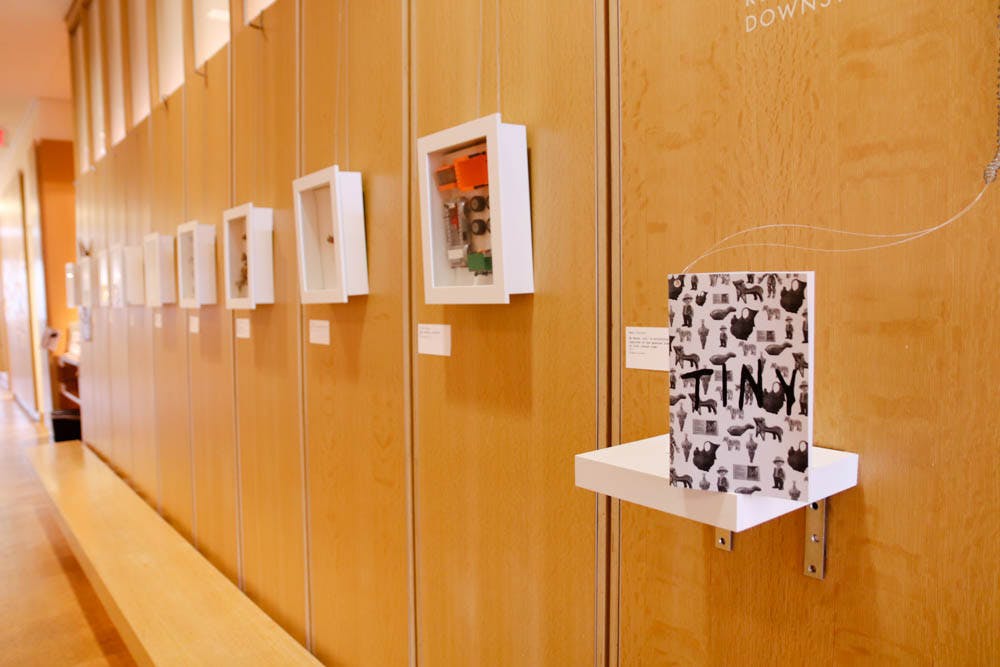From Lego figurines to silver spoons of varying sizes, “tiny,” open until April 13, showcases works that reveal the emotional, cultural and historical capacities of smallness.
The “tiny” exhibit, currently on display in Rhode Island Hall, examines the ways in which small things can communicate a story of nuance and complexity, said Felipe Rojas Silva, the U. archaeology professor whose class ARCH 0303: “tiny: Miniature Might and Meaning” worked on the exhibit in collaboration with the Joukowsky Institute for Archaeology and the Ancient World.
Though Rojas has taught classes on monumentality — architectural largeness — in the past, he “thought it would be interesting to have a counterpart that focused on very small things,” he explained. The exhibit is the culmination of the course, showcasing shadowboxes containing miniatures curated by each student.
Upon entering the exhibit, one is struck by hanging pamphlets which contain essays from students reflecting on their personal works. Rojas expressed his gratitude for his students’ willingness to be vulnerable in both their exhibition works and essays, and he hopes visitors will take time to read the pamphlets. “There are both dreams and nightmares in those little boxes,” he said.
At the opening of the exhibit, a 2016 film by artist Nina Katchadourian ’89, “The Recarcassing Ceremony,” was screened. Though it is no longer being shown at the exhibit, the film “demonstrates how bodies — including miniature Playmobil or Lego figurines — can contain or reproduce other worlds, souls and mythologies at various scales,” said James Warren, a student at the Rhode Island School of Design, in his pamphlet reflection.
Much like Katchadourian does in her filmic revival of her childhood rituals, ARCH 0303 students trace multifarious histories and treat them with care through their shadowboxes. In one project, archaeology concentrator Paige Daniela Banks ’20 recreated the miniature Lego sheep that she used to make in her childhood, according to her essay. “Being a little kid surrounded by dozens of tiny sheep made me feel powerful and proud; I had created so many tiny things,” she said.
In another project, Katrina Wardhana ’23 engaged with miniature, 3D-printed replicas of Neolithic clay figurines to communicate a powerful “sensorial” experience, according to her essay. Wardhana’s study of the Greek artifacts expands upon that of Professor of Archaeology Yannis Hamilakis, who specializes in the archaeology of the prehistoric Aegean. “The function of the objects is still relatively ambiguous, but my display wants to look for clues in their materiality to unravel their historical functions,” Wardhana explained of her motivations for the project.
“The objects I dealt with condensed all of the properties like color, texture, form and three-dimensionality into these very small things, and I was interested in how digital technology can be used by archaeologists to accentuate all the histories imbedded in this material,” she added. So, at the exhibition’s opening, Wardhana built a hologram display that “was able to rotate the object so that you could see all of the textural details without the need for touch.”
Rojas emphasized that he constructed the course syllabus around themes that could be studied across the cultures of antiquity and modernity. “I’m interested in cross-cultural comparison, so the class was organized thematically rather than chronologically or regionally,” Rojas said. He explained the course as being guided by “the capacity of very small things and community to help people to materialize power.”
The political and cultural implications of tininess were a focus of the course. Students studied miniatures as modes of resistance, particularly in creating spaces for marginalized communities to imagine their own stories, histories and futures, Rojas said.
The subtleties conveyed through the tiny objects were appreciated by visitors to the exhibit. “One of my favorite things about the exhibit is that, because the objects are small, they invite the viewer to get close and look at them,” said Jessica Porter, perations and events coordinator for the Joukowsky Institute. Much like Wardhana hoped, Porter reflected that she “was able to see all kinds of details and appreciate the materials the objects were made of and the effort put into creating them.”





